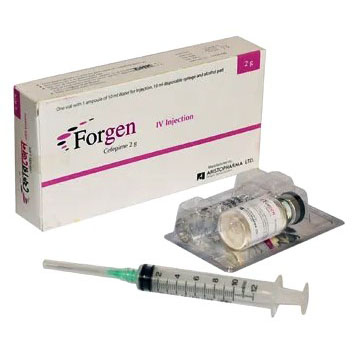Forgen Uses, Dosage, Side Effects and more
Forgen binds to one or more of the penicillin-binding proteins (PBPs) which inhibits the final transpeptidation step of peptidoglycan synthesis in bacterial cell wall, thus inhibiting biosynthesis and arresting cell wall assembly resulting in bacterial cell death.

| Attribute | Details |
|---|---|
| Trade Name | Forgen |
| Generic | Cefpirome |
| Cefpirome Other Names | cefpiroma, Cefpirome, cefpiromum |
| Weight | 500mg/vial, 1 gm/vial, 2gm/vial |
| Type | Injection, Im/iv Injection |
| Formula | C22H22N6O5S2 |
| Weight | Average: 514.577 Monoisotopic: 514.109309224 |
| Groups | Approved |
| Therapeutic Class | Fourth generation Cephalosporins |
| Manufacturer | Alkem Laboratories Ltd, Aristopharma Ltd |
| Available Country | India, Bangladesh |
| Last Updated: | January 7, 2025 at 1:49 am |
Uses
Forgen is used for:
- Severe infections, such as septicemia, bacteremia and infections in immunosuppressed neutropenic patients with hematological malignancies
- Lower respiratory infections including pneumonia
- Severe urinary tract infections including pyelonephritis
- Skin and soft tissue infections
- Bone and joint infections
- Infections in immunocompromised patients
- Other infections
Forgen is also used to associated treatment for these conditions: Gram-negative infections Bacterial Infections, Infections, Gram-Positive Bacterial
Dosage
Adult:1-2 gm every 12 hour via IV injection over 3-5 minutes or infuse over 20-30 minutes.
Elderly:There are no special precautions for its use in the elderly provided dosage is adjusted accordingly to renal function.
Forgen is administered only through the parenteral route. The dosage is dependent upon the severity and site of infection, the susceptibility of the infecting microorganisms and age, weight and renal function of the patient. The drug is administered through intravenous injection or infusion. The following dosages are recommended for moderate to severe infections in adult patients with normal renal function:
- Complicated upper & lower urinary tract infections: 1 gm 12 hourly.Total daily dose not more then 2 gm
- Skin & soft tissue infections:1 gm 12 hourly.Total daily dose not more then 2 gm
- Lower respiratory tract infections:1 to 2 gm 12 hourly.Total daily dose not more then 2 to 4 gm
- Bacteraemia or septicaemia and severe infections: 2gm 12 hourly.Total daily dose not more then 4 gm
- Infections in neutropenic patients:2gm 12 hourly.Total daily dose not more then 4 gm
Dose reduction is necessary in patients with markedly reduced renal function. After an initial dose of 0.5 -2 gm to establish a high serum concentration, the dose should be reduced by 50% for clearances of 49-21 ml/min or 75% for clearances of 20 ml/min. In end-stage renal disease, a supplementary dose equal to 50% of the recommended daily dose should be administered after each hemodialysis treatment.
The duration of treatment depends on the patient’s clinical and bacteriological response.
It is highly recommended to use the reconstituted solution immediately. During reconstitution the following procedure to be recommended and after reconstitution use within specified time line maintaining storage condition.
Step 1: Add recommended volume of solvent slowly. Remove the syringe needle.
Step 2: Gently shake the vial to dissolve the powder. Carbon dioxide is released & a clear solution will be obtained.
Step 3: Now insert the needle in the free space of the reconstituted vial & withdraw the pressurized air from the free space.
Step 4: Finally withdraw the solution from the vial by syringe.
How Long Does It Take to Work?
How Long Does It Take to Work? see here Forgen
Side Effects
Forgen is generally well tolerated. There are no predictable life threatening effects of Forgen. Adverse gastrointestinal reactions include diarrhea, nausea, vomiting, pseudomembraneous colitis, abdominal pain and have been noted 3.86% of the patients. Superficial phlebitis, thrombophlebitis and infection site reaction have been reported in 2.31% of patients receiving intravenous Forgen.
Precaution
Allergy to penicillin or to cephalosporins; renal impairment, monitor renal and haematological status; pregnancy and lactation.
Interaction
Drug interactions have not been observed with Forgen.
Pregnancy & Breastfeeding use
The safety of Forgen has not been established in pregnancy and as with all agents it should be administered with caution, especially during the early months of pregnancy. As Forgen is excreted in human breast milk, either Forgen treatment should be discontinued or breast feeding ceased.
Contraindication
Forgen is contraindicated in patients with known allergy to the cephalosporin group of antibiotics.
Acute Overdose
No cases of over dosage are known. However, general supportive care with monitoring of renal, hematological and hepatic function and coagulation status is recommended.
Storage Condition
Forgen vial should be stored below 25° C, protected from light and moisture. Reconstituted solution can be stored for up to 6 hours at room temperature and 24 hours in refrigerator (at 2-8° C) when prepared in water for injection.



